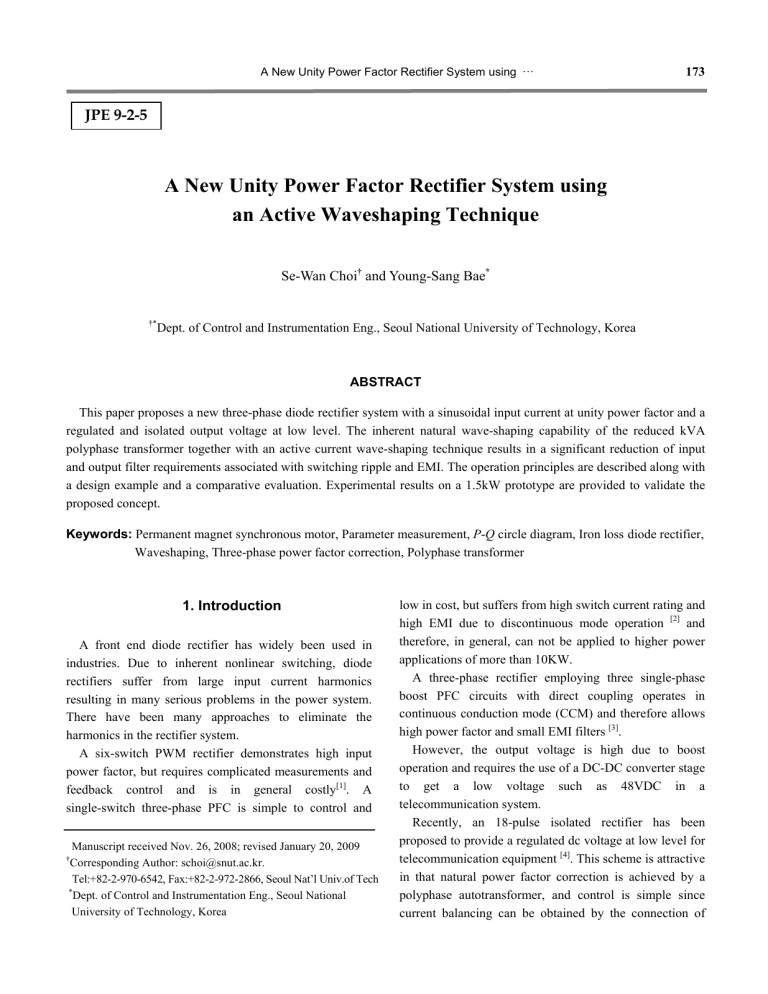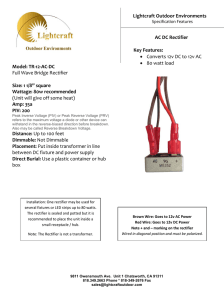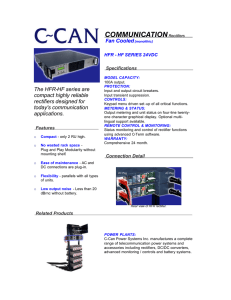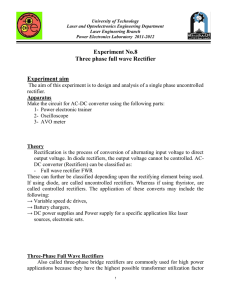A New Unity Power Factor Rectifier System using an Active

A New Unity Power Factor Rectifier System using … 173
JPE 9-2-5
A New Unity Power Factor Rectifier System using an Active Waveshaping Technique
Se-Wan Choi
†
and Young-Sang Bae
*
†* Dept. of Control and Instrumentation Eng., Seoul National University of Technology, Korea
ABSTRACT
This paper proposes a new three-phase diode rectifier system with a sinusoidal input current at unity power factor and a regulated and isolated output voltage at low level. The inherent natural wave-shaping capability of the reduced kVA polyphase transformer together with an active current wave-shaping technique results in a significant reduction of input and output filter requirements associated with switching ripple and EMI. The operation principles are described along with a design example and a comparative evaluation. Experimental results on a 1.5kW prototype are provided to validate the proposed concept.
Keywords: Permanent magnet synchronous motor, Parameter measurement, P Q circle diagram, Iron loss diode rectifier,
Waveshaping, Three-phase power factor correction, Polyphase transformer
1. Introduction
A front end diode rectifier has widely been used in industries. Due to inherent nonlinear switching, diode rectifiers suffer from large input current harmonics resulting in many serious problems in the power system.
There have been many approaches to eliminate the harmonics in the rectifier system.
A six-switch PWM rectifier demonstrates high input power factor, but requires complicated measurements and feedback control and is in general costly [1] . A single-switch three-phase PFC is simple to control and
Manuscript received Nov. 26, 2008; revised January 20, 2009
† Corresponding Author: schoi@snut.ac.kr.
Tel:+82-2-970-6542, Fax:+82-2-972-2866, Seoul Nat’l Univ.of Tech
* Dept. of Control and Instrumentation Eng., Seoul National
University of Technology, Korea low in cost, but suffers from high switch current rating and high EMI due to discontinuous mode operation [2] and therefore, in general, can not be applied to higher power applications of more than 10KW.
A three-phase rectifier employing three single-phase boost PFC circuits with direct coupling operates in continuous conduction mode (CCM) and therefore allows high power factor and small EMI filters [3] .
However, the output voltage is high due to boost operation and requires the use of a DC-DC converter stage to get a low voltage such as 48VDC in a telecommunication system.
Recently, an 18-pulse isolated rectifier has been proposed to provide a regulated dc voltage at low level for telecommunication equipment [4] . This scheme is attractive in that natural power factor correction is achieved by a polyphase autotransformer, and control is simple since current balancing can be obtained by the connection of
174 Journal of Power Electronics, Vol. 9, No. 2, March 2009 secondary windings in high frequency transformers.
In this paper, a three-phase diode rectifier based on the arrangement of a polyphase autotransformer and an active wave-shaping technique is proposed and shown in Fig. 1.
The proposed approach incorporates a 12-pulse autotransformer and two three-phase diode rectifiers, each followed by a full bridge converter operating at continuous conduction mode. An active wave shaping technique is applied to the proposed scheme resulting in sinusoidal input currents at unity power factor. The advantages of the proposed scheme are;
• Sinusoidal input current at unity power factor meeting with IEEE519 current distortion limits.
• Higher efficiency due to no use of an intermediate dc-dc conversion stage and the use of a relatively small number of components.
• Significantly reduced input and output filter requirements associated with switching ripple and
EMI due to the proposed active wave-shaping technique based on the polyphase transformer arrangement.
• Isolated and regulated dc voltage at low levels which are applicable to telecom equipment.
• Suitability for higher power applications due to CCM operation in the whole range of load variations.
The operation principles are described along with the reference signal generation and control method in the following section.
2. Proposed Active Diode Rectifier System
A. Operating Principles
Fig. 1 shows the basic configuration of the proposed rectifier system that employs a three-phase autotransformer and two three-phase diode rectifiers, each followed by a current source full bridge converter. The three-phase autotransformer is employed to supply two sets of three-phase voltages for each diode bridge which lead and lag the input source voltage by 15 ° , respectively.
The KVA rating of the autotransformer is 0.24P
o
, and this considerably reduces the size and weight compared to the equivalent ∆ -Y transformer which has a KVA rating of
1.035 P o
[5] . The operating principle is illustrated with various waveforms shown in Fig. 2.
⎡
⎢ i a
1
⎢ i b
1
⎣ i c
1
⎥
⎦
⎤
⎥
=
⎡
⎢
S
⎢ S
⎣ S a
1 b
1 c
1
⎥
⎦
⎤
⎥
⋅ i
L
1
,
⎡
⎢ i a
2
⎢
⎣ i i b c
2
2
⎥
⎦
⎤
⎥
=
⎡
⎢
S
⎢ S a
2 b
2
⎣ S c
2
⎥
⎦
⎤
⎥
⋅ i
L
2
(1)
From the autotransformer connection, the input current can be expressed in terms of rectifier input currents as [5] , i a
= i a 1
+ i a 2
+ 0 .
1547 ⋅ ( i c 2
− i b 2
+ i b 1
− i c 1
) (2)
Then, the phase ‘a’ input current can be expressed in terms of the inductor currents and the switching functions as, i a
=
{
+
S
{ a 1
S a
+
2
0 .
1547
+
⋅ (
0 .
1547
S b 1
⋅ ( S c
−
2
S
− c 1
)
}
S b
2
⋅ i
)
L 1
}
⋅ i
L
2 (3)
It can be noted from equation (3) that the input current is determined by the inductor current. If the inductor current is dc, the input current would have 12-pulse characteristics due to the natural wave-shaping capability of the autotransformer. Now, the inductor current is controlled to have a wave shape given in the following, i
L 1
*
( t
) =
2
K
2 V
LL
⋅
Min
{ v ab
( t
) , v bc
( t
) , v ca
( t
)
}
(4) i
L 2
*
( t ) = i
L 1
*
( t
−
30 °
ω
) (5)
Fig. 1 Proposed telecom rectifier system
A New Unity Power Factor Rectifier System using … 175 shape of the inductor current is a portion of the line-to-line voltages, shown as a thick line in Fig. 2. Each current source full bridge converter is operated in CCM to shape its input inductor current as given in equations (4) and (5).
Modulating the inductor current as such results in sinusoidal input currents at unity power factor as shown in
Fig. 2.
In the mean time the primary current of the high frequency transformer is determined by the switching function of the full bridge converter as, i
P
1
( t ) =
S
1
( t ) ⋅ i
L
1
( t ) (6) i
P 2
( t ) =
S
2
( t ) ⋅ i
L 2
( t )
Then the capacitor input current can be expressed as, i d
( t ) = i d 1
( t ) + i d
2
( t ) (7)
=
N p ⋅ ( i p 1
( t )
N s
+ i p 2
( t ) )
As we can see from Fig. 2 the large low order (6) harmonic in the two diode currents add up and do not appear in current i d
. Therefore the filter output capacitance is greatly reduced.
The method of generating reference signals for inductor currents is shown in Fig. 3. The normalized wave shape references, i
L1,N
and i
L2,N
are stored in the look-up table and is synchronized with a line-to-line voltage by means of zero-cross detecting and phase locked loop circuits. The magnitude references for inductor currents are also obtained by a signal from output voltage regulation.
Fig. 2 Various waveforms of the proposed scheme
Here,
K
=
I
L , pk
I o
is a scale factor which can be determined by the ratio between the input line-to-line voltage V
LL
and output dc voltage V o
. The desired wave Fig. 3 Control block diagram
176 Journal of Power Electronics, Vol. 9, No. 2, March 2009
The input and output relationship on average values of the propose rectifier system are given as,
V o
V d , av
=
1
2
⋅
( 1 −
N s
D
)
N
P
=
2 I
L
, av
I o
(8) where the operating range of the duty ratio is 0.5<D<1.
The average rectifier output voltage V
V d , av
= 1 .
035 × 1 .
35 ×
V
LL d,av becomes [5] ,
(9)
Table 1 summarizes the expression for voltage and current ratings of the transformers and switching devices.
The current ratings of the components in the proposed scheme depend on the duty ratio of the switch. The design values for a 12kW rectifier system shown in the design example are listed corresponding to the expressions.
Table 1 Component Rating Calculation
Design
Component Value
(12kW) rms voltage
V
LL
220V
From equation (8) and (9) the turn ratio of the high frequency transformer can be determined by,
N1- winding rms current
0.081
⋅
1 − D
1
2
⋅
N s
N p
⋅ I o
3.16A
N
=
N
P
N
S
> 1 .
397 ⋅
V
LL
V o
(10)
Also, the average value of the inductor current becomes,
I
L , av
= 0 .
55 ⋅
I
L , pk
(11)
From equations (8) and (11), the scale factor K can be obtained by,
K
= 0 .
65 ⋅
V o
V
LL
(12)
B. Design Example
As a design example for the proposed diode rectifier system the following parameters are assumed:
P o
= 12 kW ; V
LL
= 220 V ; V o
= 48 V
The output current I o
is given by,
Auto- transformer
Full-
Bridge
Converte r
Switch
High
Frequency
Rectifier
Diode
N2- winding
VA(%) peak voltage peak current rms current peak voltage peak current rms current rms voltage rms current
V
LL
⋅ tan15 o
3
2
3
=
∑ V rms
⋅ I
2V o
⋅ I o rms
I
I
L , rms
× 100
V o
⋅
N p
N s
I
⋅
I
L , pk
I
L , rms
2
L , pk
L , rms
2
⋅
N p
N s
⋅
N p
N s
34V
18.1A
2.9kW
(24%)
384V
35.45A
15.68A
98V
283.6A
88.7A
I o
=
P o
V o
= 250 A (13)
Then, by letting the nominal duty ratio be D = 0.6 the turns ratio can be calculated by equations (8) - (10),
N
P
: N
S
= 8 : (14)
High
Frequency
Transforme r primary peak voltage
V o
⋅
N p
N s primary peak current turns ratio
I
L
, pk
Np : Ns = 8 : 1
384V
35.45A
A New Unity Power Factor Rectifier System using … 177
C. Comparative Evaluation of the Proposed Rectifier
In this section a comparative evaluation of the proposed scheme and several other schemes concerning efficiencies, component counts, and realization efforts etc. is given.
The calculation of switch utilization, and normalized switching and conduction losses is based on the equations obtained in the literature
[7]
. The evaluation results are listed in Table 2.
The schemes considered for evaluation include single-switch PFCs, six-switch PWM rectifiers, three single-phase PFCs [3] , and 18-pulse rectifiers [4] .
The assumed operating conditions for evaluation are listed below.
• The utility source is ideal with a zero internal impedance.
• The components are ideal, unless specified otherwise.
• The system parameters given in equations (13)-(15) are used in the calculation of switch utilization and losses.
• The switching frequency is constant with f sw
= 30kHz.
• The maximum peak-to-peak ripple of the inductor current is 10% of its rms value.
• The intermediate dc voltages are 400V for single-switch PFCs, six-switch PWM rectifiers and three single-phase PFCs[3], 260V for 18-pulse rectifiers, and 307V for the proposed scheme, respectively.
The proposed scheme employs a low kVA(0.24P
o
) polyphase autotransformer followed by diode bridges as a front-end, resulting in natural waveshaping characteristics similar to the 18-pulse rectifier. Since it does not use switches operating at high frequency in the front-end conversion stage, the use of an input filter is not necessary and the requirements for using an EMI filter are reduced.
Due to continuous conduction operation in the dc-dc converter the required EMI filter size is further reduced.
The 18-pulse rectifier, which also has a significantly reduced EMI filter size, may need to use a small input filter to meet the IEEE 519 harmonic standard.
The proposed scheme shows low switch utilization in the dc-dc conversion stage. The total number of switches and diodes of the proposed scheme is fairly low, and especially the number of fast recovery diodes is the lowest, resulting in lower power losses and cost.
The switching loss of the proposed scheme is approximately half of that of the 18-pulse rectifier while the conduction loss of the proposed scheme is approximat techniques input filter or phase-shifting transformer
Table 2 Comparative Evaluation of Various Rectifiers single-switc h PFC
6-switch
PWM rectifier three single-phase
PFC[3]
18-pulse rectifier[4] proposed rectifier configuration ac-dc-dc-dc ac-dc-dc ac-dc-dc-dc ac-dc-dc ac-dc-dc number of switches dc-dc total number of diodes
(number of FRD)
4 (0.24)
(switch utilization) total 5 switching losses conduction losses
13 (7)
6 (0.1)
4 (0.24)
10
12 (12)
3 (0.18)
12 (0.24)
15
36 (24)
─
12 (0.12)
12 front-end 0.17 dc-dc 1.04
1 1.24 ─
1.04 1.04 2.04 total 1.21 2.04 front-end 0.34 2 7.49 ─ dc-dc 0.23 0.23 0.23 0.18 total 0.57 0.18
32 (14)
─
8 (0.13)
8
─
1.08
1.08
─
0.34
0.34
16 (4) input filter input filter no phase-shifting transformer
(0.2 P o
) phase-shifting transformer
(0.24 P o
) output filter inductor sensing effort
& control complexity yes yes yes medium high high yes low no medium
178 Journal of Power Electronics, Vol. 9, No. 2, March 2009 ly double of that of the 18-pulse rectifier. This is because the dc-dc converter employed in the proposed scheme is a current-fed type with the duty cycle ranging between 0.5 and 1 while that of the 18-pulse rectifier is a voltage type with the duty cycle raging between 0 and 0.5.
Among the five schemes compared, the proposed scheme is shown to have the highest efficiency due to the following reasons: (1) The total power switch losses of the proposed scheme is shown to be the smallest, (2) an intermediate dc-dc conversion stage is not employed in the proposed scheme, (3) the total number of switches and diodes is relatively low.
3. Experimental Results
A laboratory prototype has been built and the experimental results are provided. The experimental waveforms for the proposed scheme are shown in Fig.4.
The system parameters.
For the experiment are as follows:
• P o
: 1.5kW
• Supply : 220V(line-to-line, RMS), 60Hz
• V o
: 48VDC
• Dc link capacitor C o
=3300uF , Inductor L
1
, L
2
=5mH
Fig. 4(a) shows the inductor current i
L1
whose waveform is shaped by the full bridge converter. The rectifier input current i a1
, shown in Fig. 4(b), has 120 ° of discontinuous period. This results in a near sinusoidal input current, as shown in Fig. 4(c). The measured THD of the input current is 3.7%.
Based on these results, the experimental results agree with the analysis shown in Fig. 2. The validity of the control method is verified.
4. Conclusions
In this paper a new diode rectifier system for telecom applications is proposed to draw sinusoidal input current at unity power factor so that the proposed scheme meets with IEEE519 current distortion limits for loads with any short circuit current to loads current ratio.
(a) Inductor current i
L 1
(b) Rectifier input current
(c) Input current i a i a
1
(d) FFT of i a
Fig. 4 Experimental waveforms
Based on the natural wave-shaping capability of the autotransformer with low kVA rating(0.24P
o
) the proposed active wave shaping technique significantly reduces input
ripple and EMI.
References
A New Unity Power Factor Rectifier System using … 179 and output filter requirements associated with switching
The proposed scheme is also shown to have higher efficiency because it does not employ an intermediate dc-dc conversion stage and has a relatively small number of components. The proposed scheme has a regulated and isolated output voltage at low level and therefore is suitable for telecom rectifiers. Experimental results on a
1.5kW prototype have been provided to validate the proposed concept.
[1]
[2]
[3]
[4]
[5]
[6]
[7]
[8]
S. Ohtsu and S. Muroyama, K. Yamamoto, “A compact,
High -Efficiency and High-Power-Factor Rectifier for
Telecommunications Systems”,
IEEE APEC Conf
., Vol. 2, pp. 509-513, March 1996.
M. Rastogi, R. Naik, and N. Mohan, “A Comparative
Evaluation of Harmonic Reduction Techniques in
Three-Phase Utility Interface of Power Electronics Loads”,
IEEE Trans. on IA
, Vol. 30, No. 5, pp.1149-1155, Sep./Oct.
1994.
G. Spiazzi and F.C. Lee, “Implementation of
Single-Phase Boost Power Factor Correction Circuits in
Three-Phase Applications”, IEEE Trans. on Industrial
Electronics
, Vol. 44, pp.365-370, June 1997.
F.J.M.,Seixas and Barbi, I. “A 12kW Three- Phase Low
THD Rectifier with High-Frequency Isolation and
Regulated DC Output”,
IEEE Trans. on Power Electronics,
Vol. 19, pp. 371-377, March 2004.
S. Choi, P. Enjeti and I. Pitel, “Polyphase Transformer
Arrangements with Reduced kVA Capacities for Harmonic
Current Reduction in Rectifier-Type Utility Interface”,
IEEE Trans. on PE
, Vol. 11, No. 5, pp. 680-690, Sept.
1996.
S. Choi, P. Enjeti, H. Lee and I. Pitel, “A New Active
Interphase Reactor for 12-Pulse Rectifiers Provides Clean
Power Utility Interface”,
IEEE Trans. on Industry
Applications,
Vol. 21, No. 6, Nov./Dec. 1996.
B. Singh, B.N. Singh, A. Chandra, K. Al-Haddad, A.
Pandey, D.P. Kothari, “A Review of Three-phase Improved
Power Quality AC-DC Converters” IEEE Transactions on
Industrial Electronics
, Vol. 51, Issue 3, pp. 641 – 660,
June 2004.
Y. Nishida, J. Miniboeck, S. D. Round, J. W. Kolar, “A
New 3-phase Buck-Boost Unity Power Factor Rectifier with Two Independently Controlled DC Outputs”, IEEE
APEC Conf.
, pp.172-178, Feb. 2007.
P. Bozovic, P. Pejovic, “Current-Injection-Based 12-Pulse [9]
[10]
[11]
[12]
Rectifier Using a Single Three-Phase Diode Bridge”, IET
Electric Power Applications
, Vol. 1, Issue 2, pp. 209 – 216,
March 2007.
M. Shigeta, S. Saito, H. Mochikawa, “A Development of
Novel DC 48 V Power Supply System Utilizing 18-Pulse
Rectified Active DCL and Resonant Converter”,
Telecommunications Energy Conference, INTELEC
, pp.
309-316, 29 Sep.-3 Oct. 2002.
L.C. Gomes de Freitas, M.G. Simoes, C.A. Canesin, L.C. de Freitas, “Programmable PFC Based Hybrid Multipulse
Power Rectifier for Ultra Clean Power Application”, IEEE
Transactions on Power Electronics
, Vol. 21, Issue 4, pp.959 – 966, July 2006.
K. Oguchi, T. Kubota, N. Hoshi,“Asymmetrical
Nine-Phase Voltage Step-up/down Diode Rectifiers with
18-step Input Currents”, IEEE Industry Applications
Conference
, Vol. 1, pp. 177-184, Oct. 2005.
[13] J. Salmon, I. Roberge,“Performance Assessment of
18-Pulse 3-Phase Rectifiers Using Harmonic Reducing
Auto-transformers”,
Canadian Conference on Electrical and Computer Engineering , pp.637 – 640, May 2005.
Se-Wan Choi
received his Ph.D. degree in electrical engineering from Texas A&M
University, College Station, TX, in 1995.
From 1985 to 1990, he was with Daewoo
Heavy Industries as a Research Engineer.
From 1996 to 1997, he was a Principal
Research Engineer at Samsung Electro-Mechanics Co., Korea. In
1997, he joined the Department of Control and Instrumentation
Engineering, Seoul National University of Technology, Seoul,
Korea, where he is currently a Professor. He is an Associate
Editor of IEEE Transactions on Power Electronics and Journal of
Power Electronics. His research interests include three-phase power factor correction and fuel cell power conversion technologies.
Young-Sang Bae
was born in Kunsan,
Korea, in 1979. He received his B.S. degree in electrical engineering from Hoseo
University, Asan, Korea, in 2003 and the
M.S. degree from the Department of Control and Instrumentation Engineering, Seoul
National University of Technology, Seoul, Korea, in 2005. He is currently an Engineer of the Research and Development Center,
KACO Solar Korea. His research interests include utility interface and power quality issues including power factor correction.




